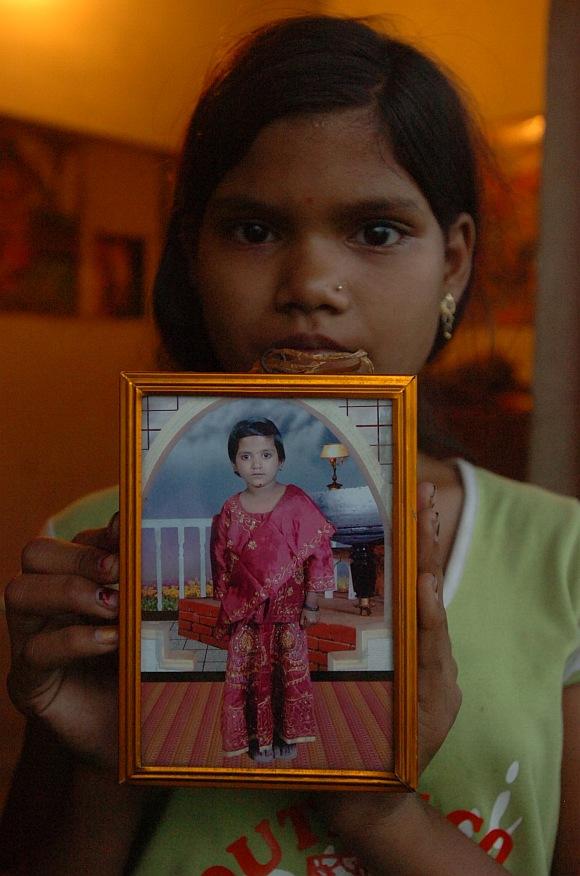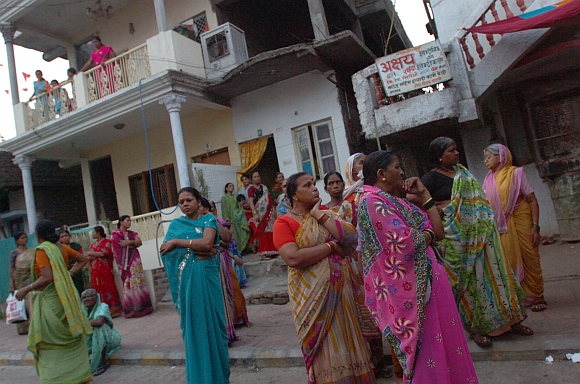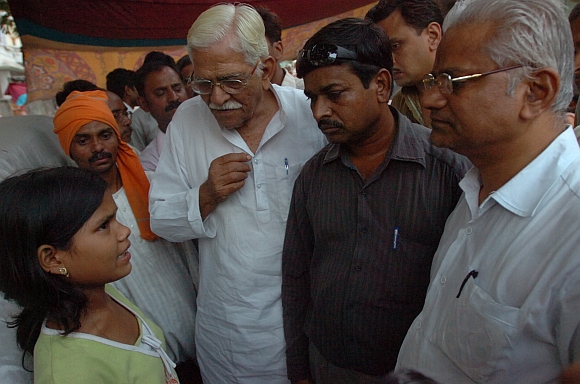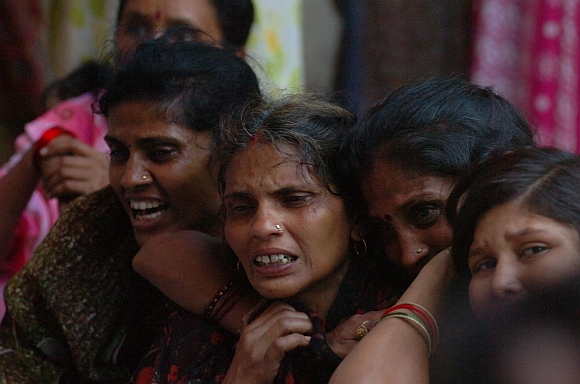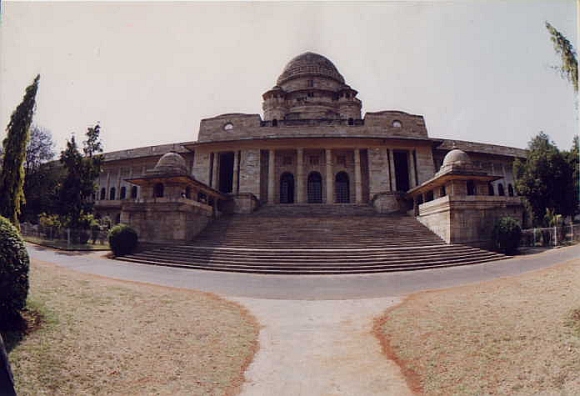 | « Back to article | Print this article |
Death at Gadkari's home: What happened to 7-year-old Yogita?
More than two years ago, 7-year-old Yogita Thakre was found dead in a car in the compound of the home where BJP politician Nitin Gadkari lives.
Toral Varia Deshpande traveled to Nagpur to uncover the mystery surrounding the child's death, a case whose investigation was severely criticised by the courts recently.
May 19, 2009, was a day like any other for Yogita Thakre, the daughter of a domestic help Vimal Thakre and her husband Ashok, who works at a tea stall in Nagpur.
After picking her seven year old from school, Vimal left the child to play in the compound of a residence in the Mahal area of the north Maharashtra city.
The residence belonged to arguably the city's best-known politician, Nitin Gadkari, then a Bharatiya Janata Party legislator in the state, and now the national president of his party.
At about 1 pm, before proceeding to work at homes close by, Vimal asked the guards at Gadkari's home and his driver Manohar Panse, who were known to both mother and daughter, to keep an eye on Yogita.
When she returned from work at about 4 pm, Vimal came looking for her daughter, but was unable to find her.
On inquiring with the guards, Vimal was told that Yogita must be playing close by. Vimal, who still had unfinished work, went ahead, thinking that she would return and locate her daughter.
"On returning around 6 pm or so, I was told by Panse that my daughter was sleeping in a car. I found it very odd because Yogita had never done such a thing earlier. When I went into the compound, Dr Paranjpe, Gadkari's neighbour, was standing near the car. On seeing me, he walked out," recalls Vimal Thakre.
"Panse, Sudhir Deolgaonkar (Nitin Gadkari's personal assistant) and Nikhil Gadkari (Gadkari's son) were also present," Vimal Thakre alleges.
"Panse asked me to take my daughter. When I went near the car, I was shocked to see my child. There was blood and injuries all over her body. She would not move when I called out her name," remembers Vimal.
"I knew something was wrong. I started crying. Before I could do something, Sudhir called for a rickshaw and literally forced me to take Yogita away from Gadkari's compound."
On December 21, 2011, a court in Nagpur severely criticised the investigating agencies probing Yogita's mysterious death.
Please click NEXT to read what happened...
The mystery of the changing cars
After much difficulty, the family registered an FIR (First Information Report) at the Kotwali police station nearby.
The family claims that while they insisted that a case of murder be registered, the local police registered only a case of an accidental death.
"Eventually the police had to add the charges of Section 302 (murder) and Section 201 (destruction of evidence), because the post-mortem report was quite explicit," says Jammu Anand, president, Domestic Workers Union, Nagpur.
Documents obtained through the Right To Information and the court records, in possession of Rediff.com, paint a shoddy picture of the police, and subsequently the state Criminal Information Department, CID, investigations which conclude that Yogita died due to accidental suffocation.
Anand, who is helping the Thakre family, observes, "The basis of a perfect investigation is the spot panchanama, inquest panchanama and a post-mortem report. But in this case the investigators have created webs of confusion to make it all look like an accidental death."
Yogita's family, their lawyer and activists helping the Thakres allege that the police conveniently replaced facts with 'newer' facts.
It started with the car from which Yogita's body was recovered by her mother. That the investigation was possibly compromised at the outset gains credence from the fact that the police, while recording the spot panchanama, noted that Yogita's body was recovered from a white Honda CRV bearing the number MH-31-DB-2727. A copy of the panchanama was obtained by the family through an RTI query.
The RTI reply notes that Yogita's father Ashok Thakre was present while identifying the white Honda CRV as the car from which Yogita's body was recovered. Interestingly, the panchanama of the Honda CRV states that the car was closely examined, but no traces of blood or any evidence was found.
However, mysteriously, at a later date and based on certain witness statements, the police, on paper, changed the colour and make of the car from a white Honda CRV to a brown Fiat Linea bearing number MH-31-CS-2727.
While the CRV is Nitin Gadkari's car, the Linea belongs to Sudhir Dive, managing director, Purti group of industries, of which Nitin Gadkari is the chairman.
It is also on record that Yogita's mother Vimal identified the Honda CRV a fortnight after the incident when the police summoned her for formalities.
Even if one assumes that Yogita's body was recovered from the Linea and not a CRV, what is intriguing is that the police investigation says that the car was locked at 10.30 am and it was opened only at 7 pm on May 19 to remove Yogita's body.
The police, so far, have not been able to explain how Yogita got into a locked car in the first place.
Please click NEXT to read what happened...
Was there blood? Or not? The contradictory police versions
During the high court hearings, Senior Police Inspector R M Kotale of the Kotwali police station told the court that there was too much pressure on him and from outside and the media and hence he mistakenly recorded the Honda CRV instead of the Fiat Linea.
"How can a police inspector make such a mistake? Isn't it his job to investigate serious cases under pressure?" asks Kiran Thakre, Yogita's eldest sister.
The police insist it could not have been a Honda CRV because they claim that Gadkari's wife had used the car to travel out of town that day.
Yogita's family alleges that Gadkari's secretary Delgaonkar ensured that the car was washed and cleaned and immediately sent it to receive Gadkari, who was returning to Nagpur from an out-of-town visit.
The high court, during its observations, noted that the car from which Yogita's body was recovered needed to be thoroughly investigated.
Forensic faux pas
Finger printing and forensic analysis are an integral part in any investigation, but the Kotwali police in a reply to an RTI application filed by Yogita's mother Vimal states that the fingerprinting of the car (the Fiat Linea) was not done as many people had touched the car while removing Yogita's body.
In the same reply, the police further added that the Honda CRV, the car from which Yogita's family alleges her mother recovered her body, was not examined at all.
The Fiat Linea was seized only on June 9, 2009, several days after the incident, as against the normal procedure of immediate seizure followed by forensic analysis.
Curiously, two departments of the Nagpur police ended up contradicting themselves before the high court judge. While the Kotwali police claimed that that the samples of a blood-stained seat cover and hair samples collected from the seat of the Linea, which were sent for chemical analysis, matched Yogita's blood and hair samples, the Nagpur crime branch's investigation mobile unit had a completely opposite version.
According to the crime branch unit, a chemical and forensic analysis of the Linea conducted on May 21 revealed that there were no fingerprints or blood stains found in the car.
"First, the police claim no fingerprinting is done. Then they go ahead and seize a different car several days after the incident. Then one department contradicts another department. I am baffled at the way the investigation is being carried out," says Naresh Kolhe, the lawyer for the Thakre family.
Please click NEXT to read what happened...
What the post-mortem report revealed
What has really become a bane of the investigation is the post-mortem report.
The seven-page memorandum virtually forced the police to change the case from accidental death to a case of murder and destruction of evidence.
When the post-mortem report with over 10 internal and external injuries was first submitted to the police, Senior Police Inspector Kotale decided to seek further opinion from the department of paediatrics at the Government Medical Hospital where Yogita was earlier being treated for congenital heart disease and sub acute bacterial endocarditis.
In her reply to Kotale's query, Dr Sayara Merchant, head of the paediatrics department, replied categorically that Yogita's condition could not be the reason for her death.
"The police tried really hard to pin the blame of her death on her illness. They were under pressure due to a strong post-mortem report. They don't have any answers as to why and how there were blood and injuries on Yogita's body, including her private parts," says the child's elder sister Kiran Thakre.
Eventually, on June 1, 2009, the Kotwali police added Sections 302 and 201 in the FIR.
The post-mortem report records nine surface injuries on Yogita's private parts, forehead, lips and abrasions on her right forearm and right knee.
The report further notes that 'these injuries can be caused by a hard and rough surface, that all the injuries were fresh', and concluding that the cause of death is 'smothering' while the manner of death is 'homicidal' or 'accidental.'
But even before a post-mortem was conducted on Yogita, the police had recorded several injuries on Yogita's body during the inquest panchanama. They had noted that there were several injuries on Yogita's forehead and blood oozing out of her nose.
Blood spots were also spotted on her underwear, indicating bleeding and injury from her private parts.
The Kotwali police sent as many as nine queries to the doctors who conducted the post-mortem on Yogita -- Dr P G Dixit and Dr T M Dhake. The doctors felt there was no evidence of forceful sexual intercourse and it was difficult to determine if sexual intercourse was attempted or not.
They also stated that Yogita's death was not homicidal.
"To me it appears that the police were themselves not sure on which report to rely on," says activist Jammu Anand.
The Thakres, who say they have lost complete faith in the police investigations, moved the Nagpur bench of the Bombay high court asking that the case be transferred from the police to the Central Bureau of Investigation.
After close to nine months of arguments, while the court rejected their petition, it came down heavily on the investigating agency and transferred the case to the state Criminal Investigation Department. The case was officially handed over to the state CID on March 5, 2011.
Please click NEXT to read what happened...
A glimpse of the high court order
A summary of what the honourable high court noted:
Perusal of the investigation papers reveals that initially the investigation into Yogita's death was carried on the belief that the death was homicidal.
Dr P G Dixit, one of the doctors who conducted the post-mortem, felt that the cause of death was smothering.
However, Dr Sayara Merchant, head of the paedriatics department, Government Medical Hospital, who was consulted about Yogita's condition by the police, felt the child's death could 'not' have occurred on account of suffocation in the car with its doors locked.
Thereafter, the prosecution sought a report from the panel of doctors at the Government Medical College, Nagpur.
Dr Dixit and Dr Dahake, the other doctor who conducted the post-mortem report, then felt that Yogita's death was not homicidal.
Initially, the investigation was carried out on the basis that the body was found in the Honda CRV and there is reference to this effect in the inquest panchnama.
However, on the basis of the statements of several witnesses, the investigating officer came to a prima facie finding that the body was found in a Fiat Linea.
The record also discloses that the car was referred to the Regional Transport Officer to declare whether the locking system of the said vehicle was in order; the RTO said said system functioned properly.
Subsequently, the car's locking system was tested at the police station and it was noticed that in two out of three attempts the locking system did not operate properly.
The record also discloses that in the post-mortem report the doctor noted injuries on Yogita and blood stains were found on her clothes.
Moreover, the guards present did not take prompt action to report the matter to the police.
The Thakre family argued before the court that this gave rise to the apprehension that the investigation was not being carried out fairly and properly.
The record discloses that though initially the investigating officer came to a prima facie conclusion that Yogita's death was homicidal and, therefore, registered the case under Sections 302 and 201 of the Indian Penal Code, later he came to the prima facie conclusion that the death was accidental.
The family argued that the officer had not come to a final conclusion and that investigations are still in progress. But considering the fact that Yogita's death occurred on May 19, 2009, and not much headway has been made by the investigating agency to come to a definite conclusion, the family felt their apprehension was not baseless.
The Thakres's petition claimed that Yogita's body was found in a Honda CRV and that her mother Vimal had identified the vehicle, but the investigating officer, on the basis of the statements made by several witnesses, came to the conclusion that the child's body was found in a Fiat Linea.
Please click NEXT to read what happened...
Yogita's death: Homicide or accident?
In the course of the investigations, the RTO felt that the locking system of the car was functioning properly; whereas the investigating agency, on the basis of the tests conducted at the police station, later found that the locking system was not operational on two out of three occasions.
Moreover, the injuries discovered on Yogita during the post-mortem and the blood stains on her clothes needed to be thoroughly investigated to find out whether her death was homicidal or accidental.
The family's petition says that with regard to the investigation carried out so far by the police, it is a fit case in which investigation deserves to be handed over to any other agency for proper and effective investigation of the various aspects of the case.
As held by the Supreme Court, investigation of a crime can be handed over to the CBI only in rare and exceptional cases. Hence, the high court ordered the investigation to be handed over to the state CID.
In Judicial Magistrate First Class Nilima Patil's words, recorded on December 21, 2011: 'Despite further direction by the high court, mere recording the statements of the witnesses, nothing is shown to have been done by the CID. It appears that no investigation was carried out keeping in mind the directions given by the high court. It showed want of appreciation of the emergent need to get at the truth of the case.'
After taking over the investigations from the local police, the CID has merely recorded statements of over 90 witnesses. No effort appears to have been made by the CID to check the veracity of the statements recorded.
For instance, while Yogita's mother claims that Nikhil Gadkari, the BJP leader's son, was watching the events of May 9, 2011, from the balcony of his home, the younger Gadkari, in his statement, stated that he was not at Gadkari Wada when the incident occurred.
On December 21, 2011, Magistrate Nilima Patil not only rejected the state CID's closure report, but was extremely critical of the agency and its investigation methods.
The judge noted that the high court, in its order, had given a reference of all aspects on which the investigation ought to have been carried out.
Magistrate Patil added, 'I have gone through the C summary report and the records. It is noted by me that, after giving the directions, the CID has only recorded the statement of witnesses and filed the C summary report concluding that no offence is made out and that the deceased died due to smothering in (the) car.'
On the investigation carried out by the CID, Magistrate Patil noted, 'It showed want of appreciation of the emergent need to get at the truth of the case. To throw light on the aspects considered by the high court, i.e., (the) reason of (the) death of (the) deceased Yogita Thakre and (the) difference of (the) car from which (the) corpus of Yogita was seized and (the) reference of the car in (the) inquest panchanama.'
'I am of the opinion that further detailed investigation is necessary and hence no case is made out to accept the C summary at this stage,' the magistrate noted.
"We are happy that the courts have at least highlighted the loopholes in the investigations," say Yogita's family members, who insist, "but what we want is that the case be transferred to the CBI."
Please click NEXT...
